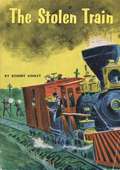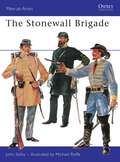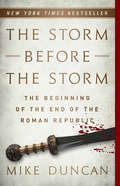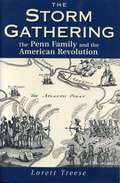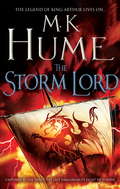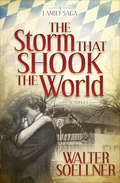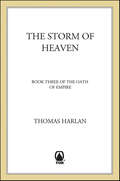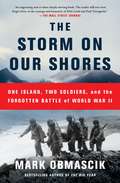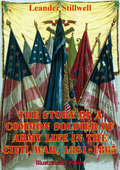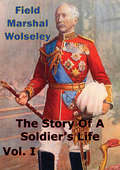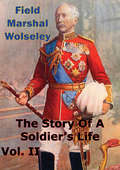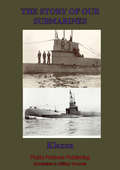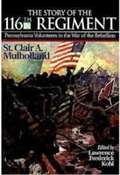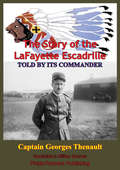- Table View
- List View
The Stolen Train
by Robert AshleyCan the small band of Union soldiers really make their daring plan work? Can they steal a train from the Confederates in broad daylight and run it all the way to Chattanooga?If they succeed, the war would be shortened by months. If they fail, they face a spy’s punishment: death by hanging.This thrilling story is based on one of the most dramatic and heroic incidents of the Civil War.
The Stone Canal: Book Two: The Fall Revolution Series (Fall Revolution Ser. #2)
by Ken MacLeod'There is more than a hint of a heroic ethic here, though the hero in question may be more like Milton's Satan than Captain Future. As much fun as [MacLeod's] books provide, it's that fierceness, that seriousness of purpose, that powers their engines and makes me want to read on.' - Locus'McLeod is writing revolutionary SF . . . A nova has appeared in our sky.' - Kim Stanley RobinsonLife on New Mars is tough for humans, but death's only a minor inconvenience. The machines know their place, and only the Abolitionists object.Until a young man walks into Ship City, a clone who remembers Jon Wilde's life as an anarchist with nuclear capability, who was accused of losing World War 3. He also remembers Dave Reid, the city's boss, who haunts Wilde's memory to the end ... a cold death in Kazakhstan. In Reid's cyborg concubine, Dee Model, both men see the image of their obsessions, and information that wants to be free. But she has ideas of her own ...THE STONE CANAL moves from the recent past into a distant future, where long lives and strange deaths await those who survive the wars and revolutions to come.The acclaimed second novel in the Fall Revolution sequence.Books by Ken MacLeod:Fall RevolutionThe Star FractionThe Stone CanalThe Cassini DivisionThe Sky RoadEngines of LightCosmonaut KeepDark LightEngine CityCorporation Wars TrilogyDissidenceInsurgenceEmergenceNovelsThe Human FrontNewton's WakeLearning the WorldThe Execution ChannelThe Restoration GameIntrusionDescent
The Stone Canal: Book Two: The Fall Revolution Series (Fall Revolutions #2)
by Ken MacLeod'There is more than a hint of a heroic ethic here, though the hero in question may be more like Milton's Satan than Captain Future. As much fun as [MacLeod's] books provide, it's that fierceness, that seriousness of purpose, that powers their engines and makes me want to read on.' - Locus'McLeod is writing revolutionary SF . . . A nova has appeared in our sky.' - Kim Stanley RobinsonLife on New Mars is tough for humans, but death's only a minor inconvenience. The machines know their place, and only the Abolitionists object.Until a young man walks into Ship City, a clone who remembers Jon Wilde's life as an anarchist with nuclear capability, who was accused of losing World War 3. He also remembers Dave Reid, the city's boss, who haunts Wilde's memory to the end ... a cold death in Kazakhstan. In Reid's cyborg concubine, Dee Model, both men see the image of their obsessions, and information that wants to be free. But she has ideas of her own ...THE STONE CANAL moves from the recent past into a distant future, where long lives and strange deaths await those who survive the wars and revolutions to come.The acclaimed second novel in the Fall Revolution sequence.Books by Ken MacLeod:Fall RevolutionThe Star FractionThe Stone CanalThe Cassini DivisionThe Sky RoadEngines of LightCosmonaut KeepDark LightEngine CityCorporation Wars TrilogyDissidenceInsurgenceEmergenceNovelsThe Human FrontNewton's WakeLearning the WorldThe Execution ChannelThe Restoration GameIntrusionDescent
The Stone Carvers
by Jane UrquhartSet in the first half of the twentieth century, but reaching back to Bavaria in the late nineteenth century, The Stone Carvers weaves together the story of ordinary lives marked by obsession and transformed by art. At the centre of a large cast of characters is Klara Becker, the granddaughter of a master carver, a seamstress haunted by a love affair cut short by the First World War, and by the frequent disappearances of her brother Tilman, afflicted since childhood with wanderlust. From Ontario, they are swept into a colossal venture in Europe years later, as Toronto sculptor Walter Allward's ambitious plans begin to take shape for a war memorial at Vimy, France. Spanning three decades, and moving from a German-settled village in Ontario to Europe after the Great War, The Stone Carvers follows the paths of immigrants, labourers, and dreamers. Vivid, dark, redemptive, this is novel of great beauty and power.
The Stone Frigate: The Royal Military College's First Female Cadet Speaks Out
by Kate ArmstrongA memoir from the first female cadet admitted to the Royal Military College of Canada. Kate Armstrong was an ordinary young woman eager to leave an abusive childhood behind her when she became the first female cadet admitted to the Royal Military College of Canada. As she struggled for survival in the ultimate boys’ club, she called on her fierce and humourous spirit to push back against the whims of a domineering and patriarchal organization. Later in life, feeling unfulfilled in her post-military career, she realized that finding her true path forward meant she had to go back to the beginning and revisit the truth of what she had experienced all those years ago.
The Stone Ponies (Black Sabre #4)
by Tom WillardFranklin LeBaron Sharps is a young paratrooper sent to Vietnam in 1965 with the celebrated 101st Airborne Division-- the Screaming Eagles. The great-grandson of Sergeant Major Augustus Sharps and the son of Brigadier General Samuel Sharps, a former Tuskegee Airman, Franklin fights a war on two fronts; in Vietnam, he is determined to repay the Viet Cong for their killing of his brother, and at home, he fights against his father's attempts to reconcile with the family he deserted. Drawing on his own experience as a paratrooper in Vietnam, Tom Willard takes a brutally graphic look at the war in its early years: a time when the United States was sorely divided and its military heroes suffered bravely both abroad and at home.
The Stone Rose: The Rose Trilogy (The She-Wolves Trilogy #3)
by Carol McGrath'A real tour de force of gripping writing, rich historical detail and complex, fascinating characters. Superb!' NICOLA CORNICK on The Stone Rose_________________EARLY READERS ARE GRIPPED BY THE STONE ROSE!* 'Springs to vivid life for the reader . . . A compulsive read' ANNE O'BRIEN* 'An enticing and intriguing tale of a woman who is driven to desperate and ruthless lengths to protect those she loves' ALEXANDRA WALSH* 'Carol McGrath really got into Isabella's head . . . Enlightening' SHARON BENNETT CONNOLLY* 'Bold and compelling' JENNY BARDEN* 'A novel that's a definite page-turner' LIZ HARRIS_________________London, 1350. Agnes, daughter of a stonemason, is struggling to keep her father's trade in a city decimated by plague. And then she receives a mysterious message from the disgraced Queen Isabella: mother of King Edward III, and widow of Edward II. Isabella has a task that only Agnes can fulfil. She wants her truth to be told.Much has been whispered of the conflicts in Isabella and Edward's marriage. Her greed and warmongering. His unspoken love for male favourites. But as Agnes listens to Isabella, she learns that she can be of help to the queen - but can either woman choose independence, follow her own desires, and survive? The sweeping third instalment of Carol McGrath's acclaimed She-Wolves Trilogy: the gripping series exploring the tumultous lives and loves of three queens of England - and of three women who lived in their shadow.Based on the extraordinary true story of the female stonemason who carved a queen's tomb!
The Stone Rose: The Rose Trilogy (The She-Wolves Trilogy #3)
by Carol McGrath'A real tour de force of gripping writing, rich historical detail and complex, fascinating characters. Superb!' NICOLA CORNICK on The Stone Rose_________________EARLY READERS ARE GRIPPED BY THE STONE ROSE!* 'Springs to vivid life for the reader . . . A compulsive read' ANNE O'BRIEN* 'An enticing and intriguing tale of a woman who is driven to desperate and ruthless lengths to protect those she loves' ALEXANDRA WALSH* 'Carol McGrath really got into Isabella's head . . . Enlightening' SHARON BENNETT CONNOLLY* 'Bold and compelling' JENNY BARDEN* 'A novel that's a definite page-turner' LIZ HARRIS_________________London, 1350. Agnes, daughter of a stonemason, is struggling to keep her father's trade in a city decimated by plague. And then she receives a mysterious message from the disgraced Queen Isabella: mother of King Edward III, and widow of Edward II. Isabella has a task that only Agnes can fulfil. She wants her truth to be told.Much has been whispered of the conflicts in Isabella and Edward's marriage. Her greed and warmongering. His unspoken love for male favourites. But as Agnes listens to Isabella, she learns that she can be of help to the queen - but can either woman choose independence, follow her own desires, and survive? The sweeping third instalment of Carol McGrath's acclaimed She-Wolves Trilogy: the gripping series exploring the tumultous lives and loves of three queens of England - and of three women who lived in their shadow.Based on the extraordinary true story of the female stonemason who carved a queen's tomb!
The Stonewall Brigade
by John Selby Michael Roffe"Look! There is Jackson standing like a stone wall. Rally behind the Virginians!" With these words General Bee ensured the reputation of Thomas Jonathan Jackson and his troops who were fighting alongside him at the battle of the First Bull Run (July 1861). This reputation was enhanced in Jackson's Shenandoah Valley campaign and other operations where the Stonewall Brigade 's actions gained the praise of their Confederate compatriots and the respect of their enemies. This book examines the uniforms, equipment, history and organization of the Brigade and its combat experience during the American Civil War (1861-1865). Detailed maps and contemporary illustrations accompany this account of their major engagements.
The Storm Before the Storm: The Beginning of the End of the Roman Republic
by Mike DuncanFrom the creator of the award-winning podcast series The History of Rome and Revolutions comes the "remarkably engaging" (Washington Post) history of the bloody battles, political machinations, and human drama that set the stage for the fall of the Roman Republic. The Roman Republic was one of the most remarkable achievements in the history of civilization. Beginning as a small city-state in central Italy, Rome gradually expanded into a wider world filled with petty tyrants, barbarian chieftains, and despotic kings. Through the centuries, Rome's model of cooperative and participatory government remained remarkably durable and unmatched in the history of the ancient world. In 146 BC, Rome finally emerged as the strongest power in the Mediterranean. But the very success of the Republic proved to be its undoing. The republican system was unable to cope with the vast empire Rome now ruled: rising economic inequality disrupted traditional ways of life, endemic social and ethnic prejudice led to clashes over citizenship and voting rights, and rampant corruption and ruthless ambition sparked violent political clashes that cracked the once indestructible foundations of the Republic. Chronicling the years 146-78 BC, The Storm Before the Storm dives headlong into the first generation to face this treacherous new political environment. Abandoning the ancient principles of their forbearers, men like Marius, Sulla, and the Gracchi brothers set dangerous new precedents that would start the Republic on the road to destruction and provide a stark warning about what can happen to a civilization that has lost its way.
The Storm Gathering: The Penn Family and the American Revolution (Keystone Books)
by Lorett TreeseTreese's book provides a popular history of Pennsylvania during the Revolutionary period from the vantage point of the heirs of William Penn.Most Pennsylvanians are familiar with the story of William Penn and the founding of Pennsylvania in 1681 as a haven for religious dissenters. But few may know what became of Penn's enterprise (the "proprietorship") in the years after his death in 1718. And fewer still may realize that Penn's descendants played an important, and increasingly unpopular, role in the coming of the American Revolution to Pennsylvania. The Storm Gathering, based on Penn family correspondence and other contemporary records, tells this fascinating story, focusing primarily on Thomas and John Penn, two of the last members of the Penn family to figure significantly in Pennsylvania's affairs before the colonies declared independence in 1776. Lorett Treese begins her story with Thomas Penn, William Penn's son who eventually became chief proprietor. Thomas groomed his nephew John (sometimes called "indolent") to be governor of the colony. When John took up his duties in 1763, at the end of the French and Indian War, the Penn proprietorship faced serious problems in managing Pennsylvania. The sheer size of the colony made it difficult for the Penns to collect their rents, and settlers moving westward clashed with Indians on the frontier, threatening the peaceful relationship that William Penn had established with native peoples. A stubborn legislature resisted Penn family control at nearly every turn, and Ben Franklin led an effort to thwart the Penns and make Pennsylvania a royal colony.According to Treese, these domestic problems diverted the Penns' attention from the growing movement in America toward democracy and independence. But by 1768, after the British parliament had passed the Townshend Act taxing the American colonies, John Penn and his uncle Thomas began to realize the magnitude of their troubles, referring to the growing rift between America and Britain as "the Storm gathering." Events began to overtake the Penns by 1775. In that year Thomas Penn died, and the bloodshed at Lexington and Concord brought war closer. In Pennsylvania, John Penn wrote that "The people here are forming themselves into companies & are daily exercising in order to be prepared for the worst." When the Second Continental Congress met in Philadelphia that summer, John knew that the end of Penn leadership was near. "Our form of government still continues," he wrote, "but I think it cannot last long . . . ." In 1776, as radical sentiment grew, the colonies declared independence from England, and Pennsylvania rewrote its constitution, divesting the Penn family of governing powers and making the colony a commonwealth. When war broke out, radical patriots forced John Penn into exile, and he eventually retired to his country home where he waited out the war. Treese concludes this engaging story with the end of the Revolution and its aftermath. While Pennsylvanians began the difficult work of reconstructing their government, the Penns attempted to salvage their personal fortunes. Many former officers of the Penn establishment participated again in government, but Penn family members were pushed outside of American government.
The Storm Lord: An adventure thriller of the fight for freedom (Twilight of the Celts #2)
by M. K. HumeThe legend of King Arthur lives on...Crippled with hunger and weary to the point of collapse, Gareth Minor enters the fortress of Arden to deliver the dire news that Lord Arthur, the Last Dragon, has been captured by barbarians and taken to the frozen north. With Father Lorcan and Germanus by his side, Gareth embarks on a quest to rescue his master.Meanwhile, in the Land of the Denes, Arthur and his fellow prisoners enrage the Dene King when they are presented at court. Fleeing for their lives, Stormbringer, their captor turned protector, leads them to safety. But the northern shores are under threat of invasion and Stormbringer and Arthur unite in battle, knowing few will survive...
The Storm That Shook the World: A Novel
by Walter SoellnerThe author of Kalvarianhof: The Perilous Journey continues his sweeping family saga with a novel of adventure and romance in Germany and war-torn Africa. Family friends for generations, Catholic Markus and Jewish Levi—young men newly home from adventures in China—find themselves and their ladies living the last wonderfully romantic days of the Belle Epoch, the Beautiful Era, before the beginning of the first World War in 1914. The two men are soon swept up by the Great War, and find themselves far from the trenches of France, but no less safe in the wilds and on the battlefields as soldiers in Kaiser Wilhelm&’s African colonies. While Markus and Levi risk their lives in the face of betrayal and terror, a new normal exists back at Kalvarianhof, the grand Levi estate deep in the forests of Bavaria. The loved ones left behind struggle with hardships and dangers unforeseen, as the shadow of war threatens their friendships, their families, and their fate.
The Storm We Made: A Novel
by Vanessa ChanNATIONAL BESTSELLER A GOOD MORNING AMERICA BOOK CLUB PICK In this spellbinding novel, an ordinary housewife becomes an unlikely spy—and her dark secrets will test even the most unbreakable ties.Malaya, 1945. Cecily Alcantara&’s family is in terrible danger: her fifteen-year-old son, Abel, has disappeared, and her youngest daughter, Jasmin, is confined in a basement to prevent being pressed into service at the comfort stations. Her eldest daughter Jujube, who works at a tea house frequented by drunk Japanese soldiers, becomes angrier by the day. Cecily knows two things: that this is all her fault; and that her family must never learn the truth. A decade prior, Cecily had been desperate to be more than a housewife to a low-level bureaucrat in British-colonized Malaya. A chance meeting with the charismatic General Fujiwara lured her into a life of espionage, pursuing dreams of an &“Asia for Asians.&” Instead, Cecily helped usher in an even more brutal occupation by the Japanese. Ten years later as the war reaches its apex, her actions have caught up with her. Now her family is on the brink of destruction—and she will do anything to save them. Spanning years of pain and triumph, told from the perspectives of four unforgettable characters, The Storm We Made is a dazzling saga about the horrors of war; the fraught relationships between the colonized and their oppressors, and the ambiguity of right and wrong when survival is at stake.
The Storm of Heaven (Oath of Empire #3)
by Thomas HarlanThe great three-sided war continues, Rome against Persia against the tribes of the desert now commanded by Mohammed of Mekkah. The tide is turning against the Eastern Empire--the Emperor Heraclius lies bedridden in Constantinople and his brother Theodore has lost a great battle to the tribes. In the West, Rome lies devastated by the long-pent eruption of Vesuvius. And in the hidden valley of Damawand, the Persion sorcerer Dahak plots his revenge.Among the lost are the Princess Shirin, vanished in the explosion of Vesuvius that wrought so much destruction, and Thyatis, still living but broken in mind and body. Her struggle will mirror the torment of the Empire, as it rebuilds its strength and purpose after so much destruction.But there is hope for the West. Prince Maxian, horrified at being the cause of so many deaths, has come to realize that the Oath need not be broken; it can be changed by a skilled sorcerer. And in Judea, young Dwyrin is coming into his full powers, honed by sorcerous combat with his friend Odenathus, who now leads the shattered remnants of the army of Palmyra. And among the Goths north of the Danuvius, a new legion is being forged, by a very old general.At the Publisher's request, this title is being sold without Digital Rights Management Software (DRM) applied.
The Storm on Our Shores: One Island, Two Soldiers, and the Forgotten Battle of World War II
by Mark ObmascikThis &“engrossing&” (The Wall Street Journal) national bestseller and true &“heartbreaking tale of tragedy and redemption&” (Hampton Sides, bestselling author of Ghost Soldiers) reveals how a discovered diary—found during a brutal World War II battle—changed our war-torn society&’s perceptions of Japan.May 1943. The Battle of Attu—called &“The Forgotten Battle&” by World War II veterans—was raging on the Aleutian island with an Arctic cold, impenetrable fog, and rocketing winds that combined to create some of the worst weather on Earth. Both American and Japanese forces tirelessly fought in a yearlong campaign, with both sides suffering thousands of casualties. Included in this number was a Japanese medic whose war diary would lead a Silver Star–winning American soldier to find solace for his own tortured soul. The doctor&’s name was Paul Nobuo Tatsuguchi, a Hiroshima native who had graduated from college and medical school in California. He loved America, but was called to enlist in the Imperial Army of his native Japan. Heartsick, wary of war, yet devoted to Japan, Tatsuguchi performed his duties and kept a diary of events as they unfolded—never knowing that it would be found by an American soldier named Dick Laird. Laird, a hardy, resilient underground coal miner, enlisted in the US Army to escape the crushing poverty of his native Appalachia. In a devastating mountainside attack in Alaska, Laird was forced to make a fateful decision, one that saved him and his comrades, but haunted him for years. Tatsuguchi&’s diary was later translated and distributed among US soldiers. It showed the common humanity on both sides of the battle. But it also ignited fierce controversy that is still debated today. After forty years, Laird was determined to return it to the family and find peace with Tatsuguchi&’s daughter, Laura Tatsuguchi Davis. Pulitzer Prize–winning journalist Mark Obmascik &“writes with tremendous grace about a forgotten part of our history, telling the same story from two opposing points of view—perhaps the only way warfare can truly be understood&” (Helen Thorpe, author of Soldier Girls).
The Stormlight Archive, Books 1-3: The Way of Kings, Words of Radiance, Oathbringer (The Stormlight Archive)
by Brandon SandersonThis discounted ebundle includes: The Way of Kings, Words of Radiance, OathbringerThe #1 New York Times bestselling epic fantasy series by Brandon Sanderson!The Stormlight Archive is the wildly imaginative epic fantasy from New York Times bestselling author Brandon Sanderson: welcome to the remarkable world of Roshar, a world of stone and storms. Uncanny tempests of incredible power sweep across the rocky terrain so frequently that they have shaped ecology and civilization alike. Roshar is shared by humans and the enigmatic, humanoid Parshendi, with whom they are at war. It has been centuries since the fall of the ten consecrated orders known as the Knights Radiant, but their Shardblades and Shardplate remain. Men trade kingdoms for Shardblades. Wars were fought for them, and won by them, but in the war against the Parshendi, the ancient weapons and armor may not be enough.Speak again the ancient oaths:Life before death.Strength before weakness.Journey before Destination.and return to men the Shards they once bore.The Knights Radiant must stand again.---Other Tor books by Brandon SandersonThe CosmereThe Stormlight ArchiveThe Way of KingsWords of RadianceEdgedancer (Novella)OathbringerThe Mistborn trilogyMistborn: The Final EmpireThe Well of AscensionThe Hero of AgesMistborn: The Wax and Wayne seriesAlloy of LawShadows of SelfBands of MourningCollectionArcanum UnboundedOther Cosmere novelsElantrisWarbreakerThe Alcatraz vs. the Evil Librarians seriesAlcatraz vs. the Evil LibrariansThe Scrivener's BonesThe Knights of CrystalliaThe Shattered LensThe Dark TalentThe Rithmatist seriesThe RithmatistOther books by Brandon SandersonThe ReckonersSteelheartFirefightCalamityAt the Publisher's request, this title is being sold without Digital Rights Management Software (DRM) applied.
The Stormlight Archive, Books 1-4: The Way of Kings, Words of Radiance, Oathbringer, Rhythm of War (The Stormlight Archive)
by Brandon SandersonThis Stormlight Archive discounted ebundle includes: The Way of Kings, Words of Radiance, Oathbringer, and Rhythm of War.The #1 New York Times bestselling epic fantasy series by Brandon Sanderson!The Stormlight Archive is the wildly imaginative epic fantasy from New York Times bestselling author Brandon Sanderson: welcome to the remarkable world of Roshar, a world of stone and storms. Uncanny tempests of incredible power sweep across the rocky terrain so frequently that they have shaped ecology and civilization alike. Roshar is shared by humans and the enigmatic, humanoid Parshendi, with whom they are at war.It has been centuries since the fall of the ten consecrated orders known as the Knights Radiant, but their Shardblades and Shardplate remain. Men trade kingdoms for Shardblades. Wars were fought for them, and won by them, but in the war against the Parshendi, the ancient weapons and armor may not be enough.Speak again the ancient oaths:Life before death.Strength before weakness.Journey before Destination.and return to men the Shards they once bore.The Knights Radiant must stand again.---Other Tor books by Brandon Sanderson The Cosmere The Stormlight Archive ● The Way of Kings ● Words of Radiance ● Edgedancer (novella) ● Oathbringer ● Dawnshard (novella) ● Rhythm of War The Mistborn Saga The Original Trilogy ● Mistborn ● The Well of Ascension ● The Hero of Ages Wax and Wayne ● The Alloy of Law ● Shadows of Self ● The Bands of Mourning ● The Lost Metal Other Cosmere novels ● Elantris ● Warbreaker ● Tress of the Emerald Sea ● Yumi and the Nightmare Painter ● The Sunlit Man Collection ● Arcanum Unbounded: The Cosmere Collection The Alcatraz vs. the Evil Librarians series ● Alcatraz vs. the Evil Librarians ● The Scrivener's Bones ● The Knights of Crystallia ● The Shattered Lens ● The Dark Talent ● Bastille vs. the Evil Librarians (with Janci Patterson) Other novels ● The Rithmatist ● Legion: The Many Lives of Stephen Leeds ● The Frugal Wizard’s Handbook for Surviving Medieval England Other books by Brandon Sanderson The Reckoners ● Steelheart ● Firefight ● Calamity Skyward ● Skyward ● Starsight ● Cytonic ● Skyward Flight (with Janci Patterson) ● DefiantAt the Publisher's request, this title is being sold without Digital Rights Management Software (DRM) applied.
The Storms of War: A Novel
by Kate WilliamsIn the idyllic early summer of 1914, life is good for the de Witt family. Rudolf and Verena are planning the wedding of their daughter Emmeline, while their eldest son, Arthur, is studying in Paris, and Michael is just back from his first term at Cambridge. Celia, the youngest of the de Witt children, is on the brink of adulthood and secretly dreams of escaping her carefully mapped-out future and exploring the world. But the onslaught of war changes everything and soon the de Witts find themselves sidelined and in danger of losing everything they hold dear. As Celia struggles to make sense of the changing world around her, she lies about her age to join the war effort and finds herself embroiled in a complex plot that puts not only herself but those she loves in danger. With gripping detail and brilliant empathy, Kate Williams tells the story of Celia and her family as they are shunned by a society that previously embraced them, torn apart by sorrow, and buffeted and changed by the storms of war.
The Story Of A Common Soldier Of Army Life In The Civil War, 1861-1865 [Illustrated Edition]
by Leander StillwellIncludes Civil War Map and Illustrations Pack - 224 battle plans, campaign maps and detailed analyses of actions spanning the entire period of hostilities."A story of the great war between the States--told from the ranksThis is an engaging recollection of the American Civil War by one of its most humble participants an ordinary soldier--later an NCO of the Union Army--in the 61st Regiment of the Illinois Infantry. His story, written in old age is surprisingly fresh, vital and full of concise detail. Here, clearly, is a man who relished recalling his time in the army and had many interesting stories of camp, campaign and battlefield action to tell. Leander Stillwell was a westerner and member of the Union army of the West, so within these pages the reader will find accounts of the Battle of Shiloh, the siege of Corinth, Iuka, Salem Cemetery, Vicksburg, Devall's Bluff, Little Rock, the Clarendon Expedition, Murfreesboro and the fight at Wilkinson's Pike."-Print ed.
The Story Of A Soldier’s Life Vol. I (The Story Of A Soldier’s Life #1)
by Field Marshal Viscount Garnet WolseleyFew men in the Victorian Age achieved the stature of Field Marshal Garnet Wolesley, a dedicated soldier, man of foresight and vision, colonial administrator and up holder of the Pax Britannica from India to Africa.Viscount Wolseley started his military career in the little-known Second Anglo-Burmese War (1852), before being plunged into the bloody senseless conflict of the Crimean War (1854-55). His disgust of the mismanagement and amateurish conduct of the British army left him with a lifelong dedication to efficiency, his men and victory. Distinguished for his bravery during the Indian Mutiny (1857-1858), at Alambagh and Lucknow, and again during an expedition to China. His globetrotting career led him to North America where he was present during the early battles of the Civil War and his anecdotes of this time are pithy and worthy enough to be quoted even to this day. Duty called him away north to Canada to re-establish British dominion over the Red River province which he did with aplomb. He was now among the top generals of the British army; and was sent to bring the Ashanti campaign to a successful conclusion. He took over command from Lord Chelmsford in 1878 after the disastrous start to the Zulu war which he ruthlessly won with tenacity and dedication. However his finest hour was yet to come in Egypt; he destroyed the rebellion of Urabi Pasha in short order after the battle of Tel-el-Kebir and commanded the ill-fated, but ultimately brilliant, effort to relieve General Gordon in Khartoum.His two volume memoirs recount his brilliant career to his famous victory in the Ashanti War 1873-1874 and are a must read for anyone interested in the Victorian age or the British Empire.
The Story Of A Soldier’s Life Vol. II (The Story Of A Soldier’s Life #2)
by Field Marshal Viscount Garnet WolseleyFew men in the Victorian Age achieved the stature of Field Marshal Garnet Wolesley, a dedicated soldier, man of foresight and vision, colonial administrator and up holder of the Pax Britannica from India to Africa.Viscount Wolseley started his military career in the little-known Second Anglo-Burmese War (1852), before being plunged into the bloody senseless conflict of the Crimean War (1854-55). His disgust of the mismanagement and amateurish conduct of the British army left him with a lifelong dedication to efficiency, his men and victory. Distinguished for his bravery during the Indian Mutiny (1857-1858), at Alambagh and Lucknow, and again during an expedition to China. His globetrotting career led him to North America where he was present during the early battles of the Civil War and his anecdotes of this time are pithy and worthy enough to be quoted even to this day. Duty called him away north to Canada to re-establish British dominion over the Red River province which he did with aplomb. He was now among the top generals of the British army; and was sent to bring the Ashanti campaign to a successful conclusion. He took over command from Lord Chelmsford in 1878 after the disastrous start to the Zulu war which he ruthlessly won with tenacity and dedication. However his finest hour was yet to come in Egypt; he destroyed the rebellion of Urabi Pasha in short order after the battle of Tel-el-Kebir and commanded the ill-fated, but ultimately brilliant, effort to relieve General Gordon in Khartoum.His two volume memoirs recount his brilliant career to his famous victory in the Ashanti War 1873-1874 and are a must read for anyone interested in the Victorian age or the British Empire.
The Story Of Our Submarines
by KlaxonThe classic Submarine story by Klaxon "The Story of our Submarines" is a gem to ad to any collection.
The Story Of The 116th Regiment: Pennsylvania Volunteers In The War Of Rebellion (Irish In The Civil War #5)
by St. Clair A. Mullholland Lawrence KohlThe 116th Pennsylvania was no ordinary regiment. For two hard years it fought with Thomas Meagher's celebrated Irish Brigade of the Army of the Potomac. Though only partially Irish itself, the 116th won an honored place in this famous unit's history by its faithful service in some of the bloodiest campaigns of the war. <p><p> The mutual respect between the Irish and the 116th was certainly founded on their shared bravery and suffering during the campaigns from Fredericksburg to Petersburg, but it no doubt also owed something to the remarkable Irish colonel, St. Clair Mulholland, who commanded the 116th through most of its battles. Mulholland was a soldier's soldier: disciplined, courageous, caring, and dedicated to the men of his regiment. Wounded four times (once, it was thought, mortally), he time and again rose from his hospital bed to return to command. Winner of the congressional Medal of Honor for his actions at Chancellorsville, he was later brevetted brigadier general and major general for service in the Wilderness and at Petersburg.
The Story Of The Lafayette Escadrille Told By Its Commander
by Captain Georges Thenault"Aces over the Western FrontThe Lafayette Escadrille is now a legend of early aeronautics and warfare in the air. Originally titled the Escadrille Americaine, this squadron of the French Air Force of the Great War was formed in 1916 and as it name suggests was piloted mainly by Americans who came to the Western Front to fight the battle of the skies for the Allies out of conviction--in the hope of encouraging the United States to join the fray--or simply in the spirit of adventure. The élan of this crack squadron has survived it and today its Indian chief insignia is instantly recognisable. There have been several books concerning the Lafayette Escadrille, but this one has unimpeachable credentials since its author was none other than the unit's commander. Few readers interested in the subject of this book will need explanation as to its contents."-Leonaur Print Version
